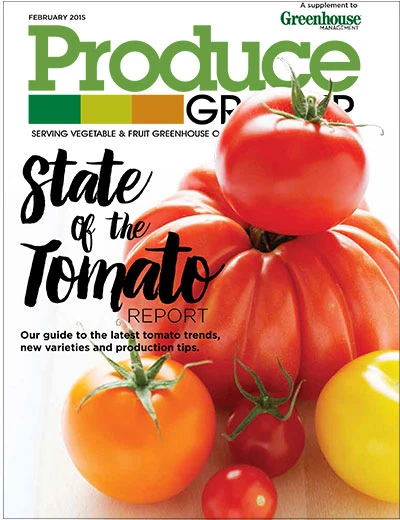
 Suspect description:
Suspect description:
- Aphids are soft-bodied insects, 0.10 to 0.25 cm in length with tubes or tail-pipes (cornicles) protruding from the end of the body. They vary in color from green, black, yellow, to pink. Because aphid color will vary depending on the plant fed upon, color should never be used to identify aphids species.
- There are a number of aphid species that feed on greenhouse-grown vegetables, including the green peach aphid (Myzus persicae) and melon/cotton aphid (Aphis gossypii).
- Aphids feed on new terminal growth and leaf undersides, causing both direct and indirect damage to greenhouse-grown vegetable crops.
- Their rapid reproductive rate may result in extensive population outbreaks within a short period of time. This is why aphids can spread quickly among vegetable (and herb) crops, which occurs more frequently when plants are spaced close together.
- Aphids feed on many greenhouse-grown vegetable crops, including lettuce, tomato, cucumber and pepper.
Spot the suspect
- A random sample of plants should be checked regularly for the presence of aphids in order to detect localized infestations.
- Aphids feeding on new growth may cause leaf yellowing and plant stunting, and leaves may appear distorted or curled upward or downward. In addition, several aphid species may vector viruses to vegetable crops.
- Indirect damage is related to the excretion of honeydew during feeding. Honeydew is a clear, sticky liquid that serves as a growing medium for certain black sooty mold fungi, which may inhibit the ability of plants to produce food by means of photosynthesis.
- Excessive aphid populations may result in the presence of white cast or molting skins that can negatively affect aesthetic appearance, although this may not result in a yield decrease.
 Preventing break-ins
Preventing break-ins
- One of the primary ways to avoid problems with aphids is to not over-fertilize vegetable plants with high nitrogen-based water soluble fertilizers. This leads to the production of soft, succulent growth that is much easier for aphids to penetrate with their mouthparts.
- Weeds inside the greenhouse should be removed promptly and deposited into containers with tight-sealing lids or placed into debris piles located away from the greenhouse. Many weeds may serve as reservoirs for aphids and the viruses they vector.
- Contact insecticides labeled for use on greenhouse-grown vegetables should be used early to prevent aphid populations from building up to damaging levels. It is important to obtain thorough coverage of all plant parts, especially leaf undersides, in order to cause substantial aphid mortality.
- Some commercially available contact insecticides that may be used include potassium salts of fatty acids (insecticidal soap) and petroleum and neem-based oils. Multiple applications will be required due to the short residual activity of most insecticides and the dispersal and reproductive ability of aphids within greenhouses, especially when environmental conditions such as temperature and light intensity are favorable.
Catching the aphid
- There are a number of natural enemies commercially available including the parasitoids, Aphidius colemani and A. ervi that, when released in a timely manner, may be effective in regulating aphid populations.
- However, natural enemies must be released before aphid populations are extensive and cause plant damage.
Get curated news on YOUR industry.
Enter your email to receive our newsletters.
Explore the February 2015 Issue
Check out more from this issue and find your next story to read.
Latest from Produce Grower
- The Growth Industry Episode 3: Across the Pond with Neville Stein
- PG CEA HERB Part 2: Analyzing basil nutrient disorders
- University of Evansville launches 'We Grow Aces!' to tackle food insecurity with anu, eko Solutions
- LettUs Grow, KG Systems partner on Advanced Aeroponics technology
- Find out what's in FMI's Power of Produce 2025 report
- The Growth Industry Episode 2: Emily Showalter on how Willoway Nurseries transformed its business
- 80 Acres Farms expands to Georgia, Texas and Colorado
- How BrightFarms quadrupled capacity in six months





